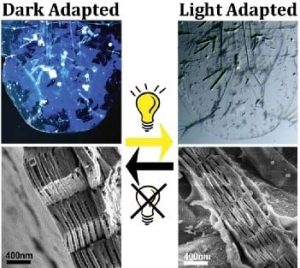The males of certain species of copepods, small marine crustaceans, produce some of the most spectacular colors in nature. These colors, used for communication with females, are produced by a wave interference effect, rather than to the presence of pigments, as presented in Advanced Functional Materials, by authors from Israel. Light impinging on the copepods interacts with a reflector layer composed of a delicate ordered arrangement of crystalline guanine and cytoplasm, which essentially tiles its entire surface. 
Surprisingly these copepods have the remarkable ability to change their color in a reversible manner in response to changes in light conditions. This is achieved by active control of the thickness of the cytoplasm layers separating the guanine crystals. Male copepods can therefore efficiently reflect light under certain conditions, while remaining transparent and hence camouflaged under others. This intricate design of structure-based color control can provide inspiration for synthetic materials with light-induced tunable colors.

















